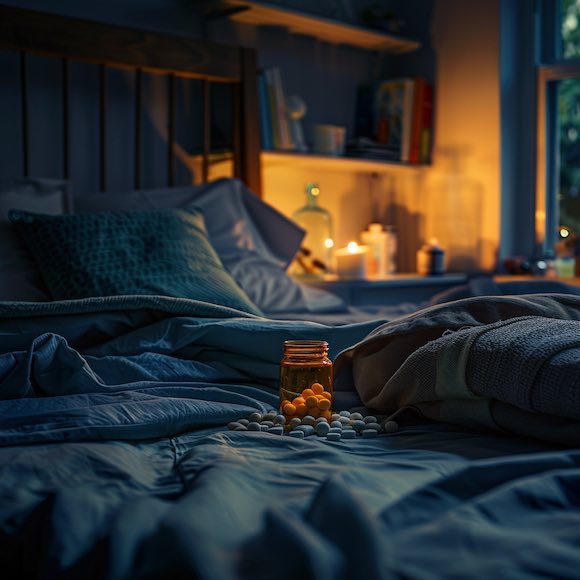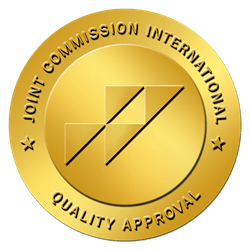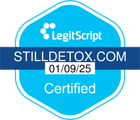Ambien: What Is It Used For?
Ambien is a prescription medication primarily used for the short-term treatment of insomnia. It is designed to help people fall asleep more quickly and improve overall sleep quality. Many individuals who struggle with occasional or chronic sleep difficulties are prescribed Ambien to reset their sleep patterns. In clinical practice, Ambien is often recommended as a temporary solution to manage insomnia while addressing underlying causes through behavioral therapies and lifestyle modifications.
Research from the National Institutes of Health (NIH) has demonstrated that short-term use of sleep medications like Ambien can be effective in improving sleep onset and duration, though it is not intended as a long-term solution1.
Zolpidem was approved in the United States in 1992. It was initially used in Europe starting in 1988 and was brought to the US market through a collaboration between Synthelabo and Searle.
A staggering 38 million of these individuals turn to sleep medications for relief, with Ambien being a popular choice. Initially introduced as a safer alternative to benzodiazepines, Ambien was believed to carry a lower risk of addiction and tolerance.
What is Ambien?
Ambien is typically available as a small, peach or pink tablet, formulated in dosages of 5 milligrams and 10 milligrams to accommodate varying levels of insomnia. There are also extended-release versions, offered in 6.25 milligrams and 12.5 milligrams, ideal for those who have trouble staying asleep. The medication can be identified by its distinctive appearance: either a blue tablet with an “A” imprint or a white, capsule-shaped tablet marked with “amb10” or “5421.”
- Ambien 5 mg (Immediate Release):
- Shape: Capsule-shaped (oblong)
- Color: Pink
- Imprint: “AMB 5” on one side and “5401” on the other
- Ambien 10 mg (Immediate Release):
- Shape: Capsule-shaped (oblong)
- Color: White
- Imprint: “AMB 10” on one side and “5421” on the other
- Ambien CR (Controlled Release):
- Shape: Round
- Color: Blue
- Imprint: “A” on one side

Is Ambien a Benzodiazepine?
Despite some common misconceptions, Ambien is not classified as a benzodiazepine. It belongs to a different group of sleep medications known as nonbenzodiazepine hypnotics. Ambien works by targeting specific receptors in the brain that help regulate sleep, but its chemical structure and mechanism of action differ from those of traditional benzodiazepines. This distinction is important because nonbenzodiazepines tend to have a shorter duration of action and a different side effect profile, which can make them more suitable for treating insomnia without some of the risks associated with benzodiazepines2.
Is Ambien a Controlled Substance?
Yes, Ambien is classified as a controlled substance. In the United States, it is listed as a Schedule IV controlled substance under the Controlled Substances Act. This classification indicates that while Ambien has a legitimate medical use, it also carries a potential for abuse and dependence. Healthcare providers closely monitor its prescription and use, and patients are advised to use Ambien strictly as directed to avoid misuse and potential side effects.
The U.S. Drug Enforcement Administration (DEA) maintains strict guidelines on the distribution and use of Schedule IV substances to minimize risks and ensure patient safety3.
Ambien Drug Class
Ambien belongs to a class of medications known as nonbenzodiazepine hypnotics, often referred to as Z-drugs. These medications include drugs like zolpidem and eszopiclone. Although they are chemically different from benzodiazepines, Z-drugs act on the same gamma-aminobutyric acid (GABA) receptors in the brain to promote sleep. Their design aims to provide the sedative effects necessary for sleep while minimizing the risk of dependence and other adverse effects commonly associated with benzodiazepines.
According to research published in the Journal of Clinical Sleep Medicine, Z-drugs like Ambien are effective in improving sleep parameters and have become a mainstay in the pharmacological treatment of insomnia4.
How Long Does Ambien Last?
The duration of Ambien’s effects is relatively short, which is one of its key characteristics. Typically, the sedative effects of Ambien last for about 6 to 8 hours, which is generally sufficient for a full night’s sleep. Its short half-life minimizes the risk of next-day drowsiness, a common concern with longer-acting sleep medications. However, individual responses can vary, and some patients might experience residual effects depending on their metabolism, dosage, and overall health.
Clinical guidelines suggest that Ambien should be used only for short-term management of insomnia to reduce the likelihood of tolerance and dependence2.
Ambien: Is It a Narcotic?
Although Ambien is a potent sleep aid, it is not classified as a narcotic. Narcotics typically refer to opioids, which are drugs used primarily for pain relief and have a high potential for abuse and dependence. Ambien, by contrast, is a nonbenzodiazepine hypnotic that works by inducing sleep rather than providing pain relief. Its classification as a controlled substance is due to its potential for misuse rather than it being a narcotic. This distinction is important for understanding both its therapeutic role and the specific risks associated with its use.
For more detailed information on the classification of medications and the differences between narcotics and non-opioid substances, resources like the FDA and DEA offer extensive guidelines and research findings35.
Street Names Of Ambien
Ambien is known by various street names, which can vary by region and even over time.
Street names of Ambien:
- A-minus
- Zombie Pills
- No-Go Pills
- Sleepeasy
- Tic-Tacs (due to its small, white appearance similar to the candy)
- Forget-Me Pill
Ambien Addiction Statistics
According to the National Survey on Drug Use and Health, in 2018, an estimated 741,000 Americans aged 12 or older abused zolpidem (the generic name for Ambien) specifically. The survey also found that in the same year:
- Adolescents (12-17 years): Approximately 46,000 reported misusing prescription tranquilizers or sedatives, including Ambien.
- Young Adults (18-25 years): An estimated 1.7 million abused these drugs during the same timeframe.
- Adults (Over 25 years): About 4.3 million admitted to misusing prescription tranquilizers or sedatives in the prior year.
- Total Estimate: Roughly 741,000 Americans aged 12 or older abused zolpidem (generic for Ambien).
Source: SAMSHA
Conclusion
Ambien is a nonbenzodiazepine hypnotic used primarily for short-term treatment of insomnia. While it is a controlled substance due to its potential for misuse, it is not classified as a narcotic. Its short duration of action and distinct mechanism of targeting GABA receptors make it an effective option for managing sleep disturbances, provided it is used according to medical guidance. If you have concerns about the use of Ambien or need more information about safe sleep medication practices, consider discussing these with your healthcare provider.
References
- National Institutes of Health. Sleep Disorders and Treatment Options. Available at: https://www.nih.gov.
- U.S. Food and Drug Administration. Ambien (zolpidem tartrate) Medication Guide. Available at: https://www.fda.gov.
- U.S. Drug Enforcement Administration. Controlled Substances Act. Available at: https://www.dea.gov.
- Journal of Clinical Sleep Medicine. Comparative Efficacy and Safety of Z-Drugs for Insomnia. Available at: https://jcsm.aasm.org.
- Centers for Disease Control and Prevention. Medication Classification and Usage Guidelines. Available at: https://www.cdc.gov.








